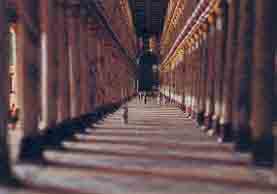Image Details

Leen Ritmeyer
Polished limestone, gold and sunshine made the Royal Stoa shine in Herod’s time. today, Garrard employs electric lights to replicate what must have been a dazzling effect. According to Josephus, the grandeur of the stoa amazed spectators. Herod based the stoa on a basilica plan, with Corinthian columns separating the central aisle from one-story aisles on each side. Josephus notes that these columns were so wide that to encircle one of them required three men with outstretched arms. The aisle to the right is bounded by the southern wall, while that to the left opens onto the Temple Mount platform. The stoa is probably the area from which Jesus “drove out all who sold and bought in the Temple” (Matthew 21: 12). The Jewish judicial, religious and legislative body, the Sanhedrin, met in the apse at the eastern end of the stoa, seen in the distance.
